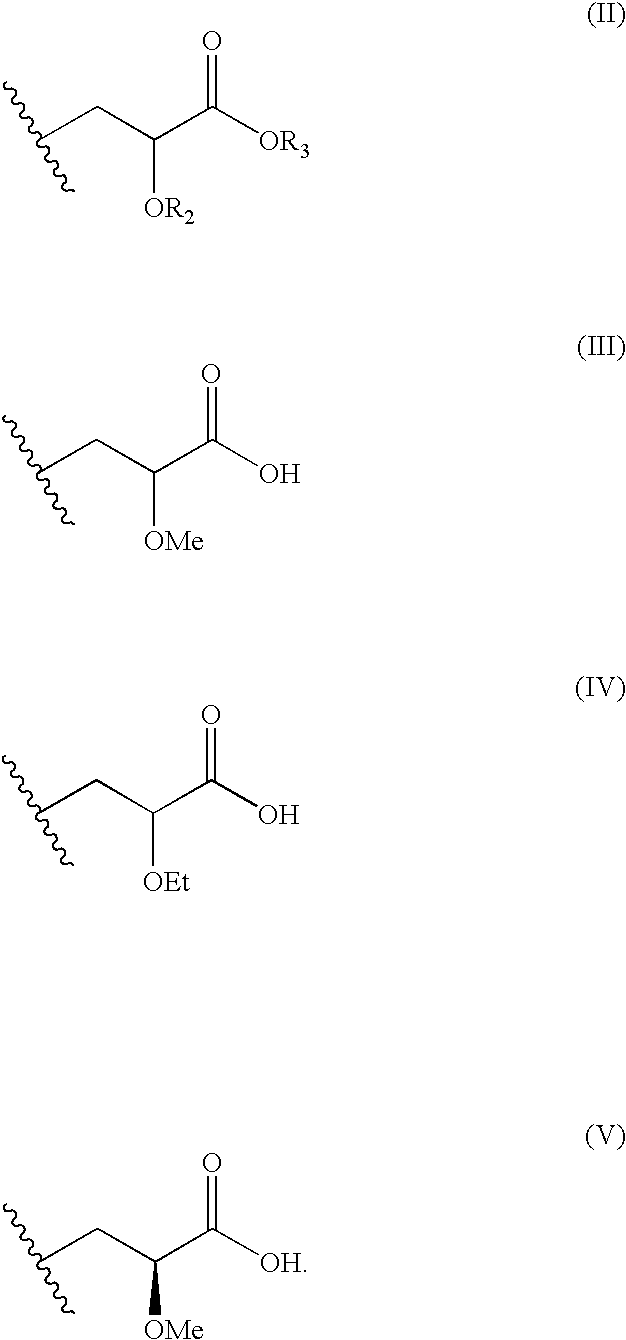Modulators of peroxisome proliferator activated receptors
a technology of activated receptors and peroxisomes, which is applied in the direction of drug compositions, cardiovascular disorders, metabolic disorders, etc., can solve the problems of insufficient insulin activation of glucose uptake, oxidation and storage in muscle, inadequate insulin repression of lipolysis in adipose tissue, and insufficient amount needed to achieve hdl elevation, and the effect of undesirable effects
- Summary
- Abstract
- Description
- Claims
- Application Information
AI Technical Summary
Benefits of technology
Problems solved by technology
Method used
Image
Examples
example 1
(2S)-3-{4-[3-(Biphenyl-4-yloxy)-prop-1-ynyl]-phenyl}-2-methoxy-propionic acid
[0623]
Step A
(2S)-2-Methoxy-3-(4-trifluoromethanesulfoxy-phenyl)-propionic acid ethyl ester
[0624]
[0625]To a solution of (S)-2-methoxy-3-hydroxyphenyl-propionic acid ethyl ester (0.388 g, 1.73 mmol) in 40 mL of dry THF cooled to −20° C. was added sodium hydride (0.073 g, 1.82 mmol, 60% oil dispersion). The mixture was stirred at −20° C. for 30 min. Phenyl triflimide (0.68 g, 1.90 mmol) was added in one portion, and the solution was stirred at room temperature overnight and concentrated to dryness under vacuum. The residue was partitioned between water (20 mL) and diethyl ether (20 mL). The layers were separated, and the aqueous solution was extracted with diethyl ether (2×20 ml). The combined organic layers were washed with 10% Na2CO3 (6×20 mL) and brine (20 mL), dried (MgSO4), and concentrated to a yellow oil (574 mg, 97%). 1H-NMR (200.15 MHz, CDCl3): δ 7.34–7.16 (m, 4H), 4.18 (q, 2H, J=7.0), 3.93 (dd, 1H, J...
example 2
(2S)-3-{4-[3-(4-Benzoyl-phenoxy)-prop-1-ynyl]-phenyl}-2-methoxy-propionic acid:
[0629]
[0630]The title compound was prepared from (2S)-3-[4-(3-hydroxy-prop-1-ynyl)-phenyl]-2-methoxy-propionic acid ethyl ester (from Example 1, Step B) via the standard Mitsunobu coupling-hydrolysis procedure (Standard Procedure A) to produce a white oily solid. 1H-NMR (200.15 MHz, CDCl3): δ 7.84–7.71 (m, 4H), 7.55–7.33 (m, 5H), 7.17 (d, 2H, J=8.0), 7.07 (d, 2 H, J=8.8), 4.96 (s, 2H), 3.96 (dd, 1H, J=7.7, 4.4), 3.35 (s, 3H), 3.11 (dd, 1H, J=14.3, 4.4), 2.97 (dd, 1H, J=14.3, 7.3).
example 3
(2S)-2-Methoxy-3-{4-[3-(4-phenoxy-phenoxy)-prop-1-ynyl]-phenyl}-propionic acid:
[0631]
[0632]The title compound was prepared from (2S)-3-[4-(3-Hydroxy-prop-1-ynyl)-phenyl]-2-methoxy-propionic acid ethyl ester via (from Example 1, Step B) the standard Mitsunobu coupling-hydrolysis procedure (Standard Procedure A) to produce a white oily solid (41%). 1H-NMR (200.15 MHz, CDCl3): δ 7.38–7.15 (m, 5H), 7.02–6.76 (m, 8H); 4.86 (s, 2H), 3.98 (dd, 1H, J=7.3, 4.4), 3.36 (s, 3H), 3.12 (dd, 1H, J=14.3, 4.4), 2.98 (dd, 1H, J=14.3, 7.3). MS (ES) for C25H22O5 [M+NH4]+: 420.2, [M+Na]+:425.2.
PUM
| Property | Measurement | Unit |
|---|---|---|
| concentration | aaaaa | aaaaa |
| weight percent | aaaaa | aaaaa |
| temperature | aaaaa | aaaaa |
Abstract
Description
Claims
Application Information
 Login to View More
Login to View More - R&D
- Intellectual Property
- Life Sciences
- Materials
- Tech Scout
- Unparalleled Data Quality
- Higher Quality Content
- 60% Fewer Hallucinations
Browse by: Latest US Patents, China's latest patents, Technical Efficacy Thesaurus, Application Domain, Technology Topic, Popular Technical Reports.
© 2025 PatSnap. All rights reserved.Legal|Privacy policy|Modern Slavery Act Transparency Statement|Sitemap|About US| Contact US: help@patsnap.com



